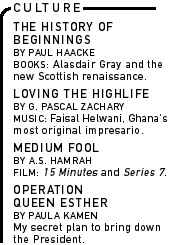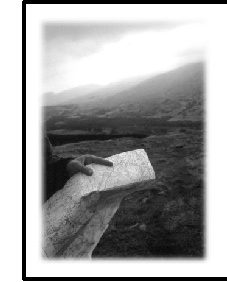

|

|

|

|
| |
|
|
|
The Book of Prefaces After Britain: New Labour
Alasdair Gray's motto--"Work as if you are living in the early days of a better nation"--is addressed to people of all nations, but it may be the best expression of the current cultural and political renaissance in Scotland. First taken from a Canadian poet for the front-page of Gray's 1983 collection Unlikely Stories, Mostly, and now appearing again on the cover of his long-awaited literary anthology The Book of Prefaces, this romantic call-to-arms epitomizes Scotland's bittersweet hopes and self-deprecating promises for the future. While most of the news media covering Britain today have been busy with the Royals and the Blairs in London and the troubles in Northern Ireland, Scotland has been working to build a new, resolutely left-wing parliament, a fresh and edgy art, music and literary culture, and a more international country out of one that has always been far warmer to Ireland, Wales and the Continent than its more powerful southern neighbor. According to Tom Nairn's incisive and provocative book After Britain: New Labour and the Return of Scotland, this national re-emergence is in fact helping to bring about the peaceful and democratic "break-up of Britain," as he predicted in his 1972 book of that name, and the end of the entire United Kingdom as we know it. For as devolution progresses, Nairn argues, it will eventually pave the way to a post-
Turning Francis Fukuyama on his head, Nairn explains with cutting irony that "the end of history lay for Scots in 1707," when the country was joined with England through a shotgun wedding of the latter's design. (In a review of Nairn's book, the End of History theorist shot back in Prospect Magazine under the banner "Don't Do It Britannia," arguing that devolution will spell trouble for both British and American imperialism--as if that were a bad thing.) Because Scotland was not powerful enough to refuse its longtime oppressor's offers, and because both nations benefited from each other as British industry, capitalism and colonialism exploded over the next few centuries, the marriage managed to last throughout the rise and fall of the British Empire, two world wars and the triumph of America as the world's English-speaking superpower. Although Scottish nationalism experienced a revival in the 20th century--especially in the '60s with the collapse of local industries and the rise of anti-colonial movements around the world--it was only after Thatcher took over Britain in 1979 that the marriage really began to fall apart. Under Tory rule from London for almost two decades, the overwhelmingly Labour-supporting Scots grew ever more disenfranchised from British life, becoming guinea pigs for right-wing political and economic experiments that they never supported in the first place. So when Tony Blair (who is of Scottish origin himself) came to power supporting devolution--and when the referendum for Scottish home rule was finally passed in 1998--the dark clouds of conservatism appeared all but swept away. Except the story does not end there. For Nairn, it continues with Blairism turning out to be a weak, unsatisfactory solution to Thatcherism, and the Scottish body politic rising up to supplant the very man who helped create it in the first place--just like the uncanny heroine of Alasdair Gray's 1992 novel Poor Things, who escapes the paternalistic, Frankenstein-like scientist who gave her life only to become his more enlightened, socialist replacement in the end. And so in stark contrast to the closed, conservative rhetoric of the end of history, the re-emergence of Scotland is opening up a new and progressive sense of beginning. For regardless of what changes devolution will or could bring, a remarkable creativity has already been flowering in Scottish culture for years, and in many ways, writers have been at the center of it all. Over the past 10 to 20 years, a number of Scottish writers have emerged, often from working-class backgrounds, to international acclaim: not just Trainspotting author Irvine Welsh, but Booker-prize winner James Kelman, Iain Banks, William Boyd, A.L. Kennedy, Andrew O'Hagan, Alan Warner, Janice Galloway, crime writers Philip Kerr, Ian Rankin and Christopher Brookmyre, and even J.K. Rowling, who finished her first Harry Potter book thanks to a grant from the Scottish Arts Council. But the writer who in many ways prefigured this literary renaissance in the '70s and '80s--Alasdair Gray--is woefully under-recognized here in the States and only somewhat more so in England. This is a shame, not only because his imagination has been one of the driving forces behind the growth of Scottish literature, but because he is one of the more innovative and entertaining writers living anywhere today. Perhaps the best symbol of the renaissance that Gray helped engender is the recent publication of his life's work, The Book of Prefaces, an historical collection of beginnings assembled in poetic opposition to the rise of Anglo-American conservatism. A bestseller in Scotland when published last summer, The Book of Prefaces is literally an anthology of prefaces, introductions, prologues and forwards to famous works of "literate thought" in the English language, beginning in the seventh century and ending, due to copyright costs, at the beginning of the 20th. Colorful in style, with witty asides and broad critiques, the book is also colorful in production: While the prefaces themselves are printed in black in the middle of each page, they are accompanied by commentary, illustrations and titles in bright red along the margins--a visual effect that only further highlights the strange fact everything in the book is both introduction and body. "This book is NOT a monster created by a literary Baron Frankenstein," Gray explains on the inside of his characteristically witty and artful dust jacket, "but a unique history of how literature spread and developed through three British nations and most North American states." In many ways, Gray is a curious novelty among writers today. For
one, he designs and illustrates his books himself, his visual style
like that of a modern-day William Blake under the influence of Glaswegian
art nouveau designer Charles Rennie Mackintosh. For another, his
leftist worldview is imbued with a uniquely Scottish double- Gray's most lauded work is his bestselling first novel, Lanark (begun in 1969 but not published in full until 1981), a visionary, nonlinear Bildungsroman that shifts between post-industrial Glasgow and a fantastic version of it called "Unthank." It has been considered a kind of Scottish Ulysses, but its influences are so diverse that it is impossible to cite only one (Gray actually lists many of them in the "Index of Plagiarisms" near the end of the book). Some of his other novels include the aforementioned Poor Things; The Fall of Kelvin Walker, a comic fable about a Nietzschean young man from a small Scottish village who tries to climb to the top of the power elite in '60s London; and the wicked, quasi-pornographic novel 1982 Janine, which parodies both Anglo-American conservatism and the masculine conventions of working-class Scottish fiction by adopting the frustrated voice of a blue-collar, Tory alcoholic who drifts between drunken memory and fantasy while "tippling" in his hotel bedroom. Of all Gray's works, however, it is The Book of Prefaces that has been labored over the longest. After several setbacks, it is the culmination of 16 years of work and significant editorial input from some 30 other writers, including Kelman, Kennedy and Galloway, poets Liz Lochhead and Tom Leonard, and scholars Angus Calder, Susan Castillo and Duncan Wu. From a witty and opinionated perspective--a welcome departure from the false objectivity of the conventionally liberal Norton or Oxford anthologies--the book traces the history of writing from "The First English," (such as the earliest translation of Genesis, attributed to Caedmon of Northumbria circa 675, and Beowulf) and "English Remade" (e.g. Chaucer), up through "The Great Flowering" of Marlowe, Spenser, Donne and Shakespeare and the period "Between Two Revolutions," where we find the likes of Hobbes, Milton, Bunyan, Behn and Dryden. After that we have the rise of literary modernity in "The Establishment"--canonical favorites like Defoe, Swift, Fielding, Richardson, Sterne and philosophers Locke, Hume and Bentham, and "The Disturbed Established"--everyone else's favorites, like Paine, Blake, Austen, Wordsworth, Coleridge, Keats, Byron, Poe and the Shelleys (not to mention Edmund Burke). The book comes to a close just before the rise of modernism with "Liberal English," where we find a range of British, Irish and American writers like Tennyson, Charlotte Bront, Harriet Beecher Stowe, Hawthorne, Melville, Dickens, Eliot, Whitman, Darwin, Mill, Twain, Stevenson, Wilde, Conrad and Shaw. The commentary that runs in red throughout the book keeps all of this firmly in place, mostly by explicating unjust social contexts, cutting the grandiose down to size and giving the under-appreciated their rightful due (exemplified by the opening line of the first essay "On What Led to English Literature": "Babies embarrass masterful men who find it queer that once they too could only wail, suck and excrete"). Gray's wonderfully sharp tongue, made even more cutting by the relative lack of space in the margins, renders even the simplest critical points uproarious. For instance: "Defoe: London Bachelor's son ... prints Robinson Crusoe as a true tale warning all youths in the middle station of lifeā to do as dad orders & never go to sea; quietly lets that moral disappear: Crusoe ends ruling a busy island of faithful blacks." Or, on Gerard Manley Hopkins' religiosity: "Certainly those of us who think that Christ and the Church are very little of absolutely everything are often left asking: What use to us is a fettered propagandist of spectacular literary skill? However, at the very least, possibly nowhere outside of Dante has an insistent and often aggressive credalism been so voluptuously well expressed." And finally, Gray argues that the violence of the French Revolution was nothing compared to "those killed in the seven-year war between Austria and Prussia thirty years before, a war that enlarged one nation at the expense of the other, did no harm to the monarchs who ordered it, gave hope of a better future to nobody." Of course, any critic could find something to complain about in a project so bold and ambitious, and by no means does this one purport to be objective, exhaustive or fair. Some readers' favorite authors may well be absent--"Where's Emerson? Where's Thoreau?" an American might complain--and indeed, Gray himself admits in his postscript that he regrets excluding Henry James and William Morris. But aside from Arthur Conan Doyle, those who are certainly not overlooked are the major Scottish writers of intellectual and literary history. The book also betrays more serious problems, however. Although there are a number of important women writers represented--there's even extra effort to include Virginia Woolf, whose discussion in A Room of One's Own of Aphra Behn is adapted for the book's running commentary--most of the women who are included are casually referred to only by their first names: "Mary" for Mary Wollstonecraft or Mary Shelley, "Charlotte" for Charlotte Brontë, and so on. Furthermore, if "the problem of the Twentieth Century is the problem of the color line," as W.E.B. Du Bois wrote in his 1903 preface to The Souls of Black Folk, it is one left starkly absent in Gray's anthology, which does not include Du Bois or any other writer of color. This is probably more a symptom of the book's Eurocentric framework rather than any narrow kind of Scottish nationalism, which, despite its politically shifty past, now rails against racism and xenophobia in the name of democratic socialism. To be fair, Gray does lament in his postscript that copyright costs made him abandon his original plan to continue through the remainder of the 20th century and include "those who now write Australian, Asian, African and Caribbean kinds of English." But since the book managed to make enough room for Wilfred Owen's last-breath response to World War I, it remains at least questionable why African-American culture was left to be represented only by Uncle Tom's Cabin and Huckleberry Finn. Despite these limitations, The Book of Prefaces is an indisputably important work, a major addition to intellectual history and literary criticism that should be both welcomed and well-thumbed. For ultimately, Gray's eccentric anthology offers nothing less than a useful, ironically-distanced approach to modern humanism. At the beginning of his postscript, Gray admits he did have some shortcomings when he first embarked on the book: "You may deduce, dear reader, that although I was then over fifty I still believed in the progressive view of history--believed that each generation had added good new social and scientific and artistic works to those of the past, thus giving more people comfort, security and freedom for the future." But Gray has come to question this view. For given the "world-wide triumph of international capitalism with United States and British armed forces as its most militant powers," and, in Britain, "the biggest sale of public property to private businesses since the dissolution of the monasteries in 1540, the abolition of common land in the 1820s," he recognizes that it may be a while before the horrific injustices and inequalities of history can really be undone. On a more sober note, he concludes that if nothing else, a progressive public education remains the best way for everyone to have an equal opportunity for advancement, just as it helped him and other working-class kids gain knowledge when free access to learning was still one of Britain's main priorities. Since even this is up for grabs these days, Gray ends his book
by calling it a "memorial" to such an education--but all hope is
not lost. For future readers, his dust jacket provides a clear warning:
"Only the rich and illiterate can ignore our anthology." Paul Haacke, a writer in New York, recently spent some time in Glasgow.
|


